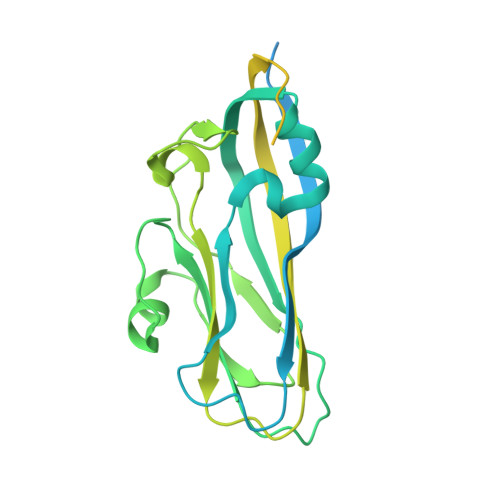Molecular Mechanism of pH-Induced Protrusion Configuration Switching in Piscine Betanodavirus Implies a Novel Antiviral Strategy.
Sterbova, P., Wang, C.H., Carillo, K.J.D., Lou, Y.C., Kato, T., Namba, K., Tzou, D.M., Chang, W.H.(2024) ACS Infect Dis 10: 3304-3319
- PubMed: 39087906
- DOI: https://doi.org/10.1021/acsinfecdis.4c00407
- Primary Citation of Related Structures:
8XID, 8YF6, 8YF7, 8YF8, 8YF9 - PubMed Abstract:
Many viruses contain surface spikes or protrusions that are essential for virus entry. These surface structures can thereby be targeted by antiviral drugs to treat viral infections. Nervous necrosis virus (NNV), a simple nonenveloped virus in the genus of betanodavirus, infects fish and damages aquaculture worldwide. NNV has 60 conspicuous surface protrusions, each comprising three protrusion domains (P-domain) of its capsid protein. NNV uses protrusions to bind to common receptors of sialic acids on the host cell surface to initiate its entry via the endocytic pathway. However, structural alterations of NNV in response to acidic conditions encountered during this pathway remain unknown, while detailed interactions of protrusions with receptors are unclear. Here, we used cryo-EM to discover that Grouper NNV protrusions undergo low-pH-induced compaction and resting. NMR and molecular dynamics (MD) simulations were employed to probe the atomic details. A solution structure of the P-domain at pH 7.0 revealed a long flexible loop (amino acids 311-330) and a pocket outlined by this loop. Molecular docking analysis showed that the N-terminal moiety of sialic acid inserted into this pocket to interact with conserved residues inside. MD simulations demonstrated that part of this loop converted to a β-strand under acidic conditions, allowing for P-domain trimerization and compaction. Additionally, a low-pH-favored conformation is attained for the linker connecting the P-domain to the NNV shell, conferring resting protrusions. Our findings uncover novel pH-dependent conformational switching mechanisms underlying NNV protrusion dynamics potentially utilized for facilitating NNV entry, providing new structural insights into complex NNV-host interactions with the identification of putative druggable hotspots on the protrusion.
Organizational Affiliation:
Chemical Biology and Molecular Biophysics Program, Taiwan International Graduate Program, Academia Sinica, Taipei 11529, Taiwan.















